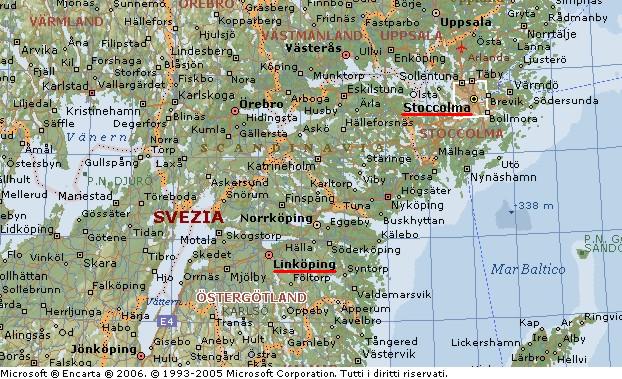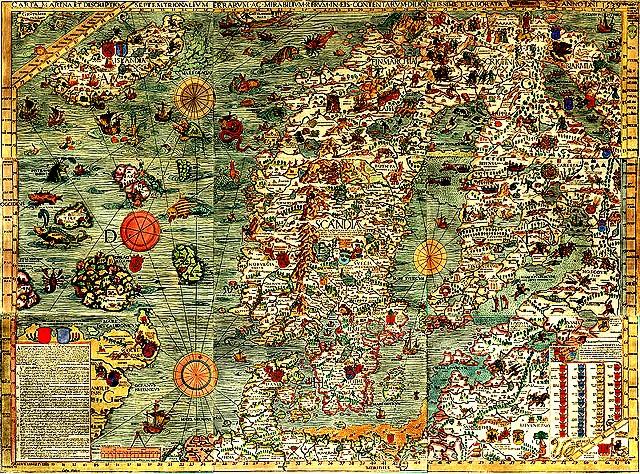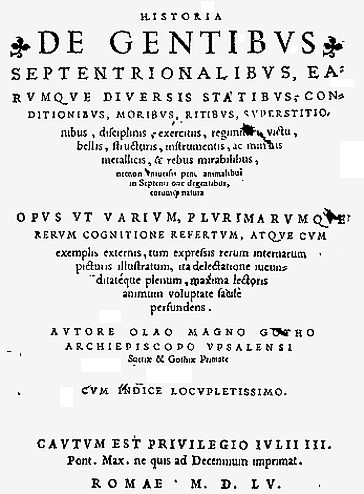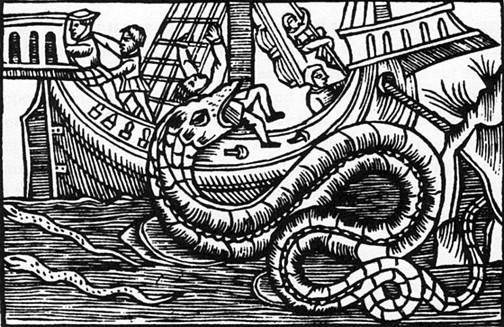Lessico
Olaus Magnus
Olof Månsson
Probabile
autoritratto di Olaus Magnus mentre sta guidando il suo cavallo
attraverso le montagne che separano Svezia e Norvegia,
ambedue dotati di racchette da neve.
Carta marina (1539), James Ford Bell Library, University of Minnesota.
Polli
e pseudopolli scandinavi ![]()
È opportuno corredare la biografia di Olaus Magnus con un probabile autoritratto, come suggerisce Margareta Lindgren nella sua relazione al simposio sulla Carta marina svoltosi nel 2003 dal titolo Olaus Magnus, Carta Marina of 1539, and Historia, 1555. Infatti non possediamo alcun ritratto autentico di Olaus. Si può supporre che egli abbia raffigurato se stesso nel foglio E della Carta marina proprio al centro della mappa e forse è l'uomo che a piedi insieme al suo cavallo - ambedue con racchette da neve - sta attraversando il crinale che separa la Svezia dalla Norvegia.
Il nome di Olaus Magnus era Olof latinizzato in Olaus mentre il cognome Magnus era la latinizzazione di Månsson, figlio di Måns. Magnus Olaus alias Månsson Olof: vescovo cattolico, umanista, storico e cartografo svedese (Linköping 1490 - Roma 1557). Linköping è oggi capoluogo della contea di Östergötland, 170 km a sudovest di Stoccolma.

Olof era
fratello di Jöns Månsson alias Johannes Magnus (Linköping 1488 - Roma 1544)
che nel 1523 era diventato arcivescovo di Uppsala. Dopo studi presso varie
università straniere, nel 1518 Olof ebbe l'incarico di accompagnare
attraverso il nord della Svezia il legato papale Giovannangelo Arcimboldi![]() - che
vendeva indulgenze a tutto spiano per costruire la basilica di San Pietro -
acquisendo così conoscenze profonde del proprio Paese. Come cattolico Olof
venne in conflitto con re Gustavo I di Svezia - Gustav Eriksson Vasa - salito
al trono nel 1523, sostenitore della nuova Chiesa luterana, tant'è che nel
1524 Olof scelse di vivere in esilio prima a Danzica poi a Roma, imitato dal
fratello Johannes che si unì a lui, e nel 1538 godettero anche dell'ospitalità
del Doge di Venezia.
- che
vendeva indulgenze a tutto spiano per costruire la basilica di San Pietro -
acquisendo così conoscenze profonde del proprio Paese. Come cattolico Olof
venne in conflitto con re Gustavo I di Svezia - Gustav Eriksson Vasa - salito
al trono nel 1523, sostenitore della nuova Chiesa luterana, tant'è che nel
1524 Olof scelse di vivere in esilio prima a Danzica poi a Roma, imitato dal
fratello Johannes che si unì a lui, e nel 1538 godettero anche dell'ospitalità
del Doge di Venezia.

Carta marina
Nel 1544, alla morte del fratello Johannes, Olaus fu nominato arcivescovo di Uppsala, ma non raggiunse mai la sua sede, preferendo vivere in esilio, durante il quale pubblicò due opere che lo resero celebre. La prima aveva il titolo di Carta marina et descriptio septentrionalium terrarum ac mirabilium rerum in eis contentarum in 9 fogli (1539) accompagnata da un commento in latino nella parte inferiore sinistra della mappa, nonché da due commenti stampati a parte, il più lungo in italiano, Opera breve, laquale demonstra, e dechiara, overo da il modo facile de intendere la charta, over delle terre frigidisseme di Settentrione, e quello più succinto in tedesco, Carta marina: Karte und Beschreibung der nordischen Länder mit ihren wunderlichen Dingen da cui forse Gessner attinse i dati per i suoi trattati di zoologia.
La Carta marina costituì un abbozzo di ciò che sarebbe stato più tardi pubblicato col titolo di Historia de gentibus septentrionalibus (1555), una preziosa esposizione della vita, dei costumi, della fauna e della flora scandinava del Cinquecento, una descrizione di grande valore se si considera che fino ad allora le regioni nordiche erano note come terra incognita. L'Historia de gentibus septentrionalibus è corredata da circa 500 illustrazioni realizzate dallo stesso Olaus che, come già detto, ne prese spunto quando accompagnò nel 1518-1519 Giovannagelo Arcimboldi attraverso il Norrland, regione storica della Svezia settentrionale composta dalle attuali contee di Jämtland, Västernorrland, Västerbotten e Norrbotten.

Dell'Historia stilata in latino vennero pubblicate edizioni integrali in italiano, tedesco, inglese, francese e olandese, nonché dei sunti, delle epitome, tant'è che - per esempio - in italiano i singoli capitoli erano preceduti dalla specifica abbreviamento. Nemo propheta in patria: infatti la traduzione svedese di una parte dell'Historia venne pubblicata fra il 1909 e il 1925, per essere ultimata solo nel 1951.
2454 Olaus Magnus è un asteroide della fascia principale. Scoperto nel 1941, presenta un'orbita caratterizzata da un semiasse maggiore pari a 2,2517715 UA e da un'eccentricità di 0,2023520, inclinata di 4,73016° rispetto all'eclittica.
Arcimboldi Giovannagelo: arcivescovo di Milano (Milano ca. 1485 - 1555). Laureato in legge, assolse diversi incarichi presso il duca Massimiliano Sforza, ma passò ben presto a Roma, dove Leone X lo nominò protonotario e nel 1514 nunzio apostolico: così lo inviò nei Paesi Bassi, in Germania e negli Stati scandinavi (1518) a vendere indulgenze per la costruzione della basilica di San Pietro iniziata nel 1506 durante il pontificato di Giulio II e terminata, con la facciata, nel 1612. Nel 1526 Clemente VII nominò Giovannagelo vescovo di Novara e nel 1550 divenne arcivescovo di Milano.
Olao Magno
Olao Magno (Linköping, 1490 – Roma, 1557) è stato un umanista, geografo e ecclesiastico svedese. Olof Månsson (il cui nome fu poi latinizzato in Olaus Magnus ed è italianizzato in Olao Magno), dopo avere compiuto gli studi superiori a Rostock, in Germania, nel 1518 compì un lungo viaggio, come legato pontificio, nel Nord della Svezia, in visita alle esigue comunità cristiane dell'epoca, immerse in un ambiente ancora essenzialmente pagano. Successivamente fece da segretario al fratello maggiore Giovanni Magno, che dal 1523 fu arcivescovo di Uppsala e ambasciatore di Svezia.
Nel 1523 fu inviato dal sovrano svedese Gustavo I Vasa in missione in Italia e da allora, a causa del progressivo affermarsi in Svezia della Riforma luterana, non fece più ritorno nel suo paese. Dal 1529 al 1539 visse con il fratello a Danzica, trasferendosi poi a Venezia, dove pubblicò la Carta marina, e successivamente a Roma. Nel 1544 fu nominato arcivescovo di Uppsala, ma non poté raggiungere la sua sede. Come primate di Svezia in esilio partecipò attivamente al Concilio di Trento. A Roma, organizzando una stamperia, si occupò personalmente della stampa delle opere proprie e del fratello. Le opere di Olao Magno diffusero in Europa meridionale la conoscenza dei paesi scandinavi.
Nel 1539 Olao Magno pubblicò a Venezia la Carta marina et Descriptio septemtrionalium terrarum, una carta geografica abbastanza attendibile dell'Europa del Nord, dalla Groenlandia meridionale alle coste baltiche della Russia, terre che all'epoca erano quasi completamente sconosciute in Europa meridionale. Nel 1533 pubblicò una biografia di Santa Brigida e nel 1555 la sua opera principale, la Historia de gentibus septentrionalibus, in 22 libri. Nonostante il titolo, non si tratta di un'opera di storia. Anche se vi è inclusa la narrazione di alcuni episodi storici, tratti per lo più da Sassone il Grammatico, l'argomento principale è la descrizione di usi, credenze e istituzioni degli svedesi. Molto spazio è dedicato anche alle tecniche, in particolare agricole e belliche e all'ambiente naturale, dalla geografia alla mineralogia, dai fenomeni meteorologici alle correnti marine. Le descrizioni sono in genere realistiche e accurate. Gli ultimi sei libri, in particolare, sono dedicati agli animali, domestici e selvatici, presenti in Svezia, includendo anche i mostri che si credeva popolassero gli abissi marini. L'opera fu tradotta e pubblicata in tutte le principali lingue europee e costituì a lungo il principale testo di riferimento sull'argomento dei popoli scandinavi.

Serpente di mare - Historia de Gentibus Septentrionalibus
Olaus Magnus (Olaus Magni or Olaus Magni Gothus) was a Swedish ecclesiastic and writer, who did pioneering work for the interest of Nordic people. He was reported as born in October 1490 in Östergötland, and died on August 1, 1557. Magnus, Latin for the Swedish Stor “great”, is a Latin family name taken personally, and not a personal epithet. His real name was Månsson; son of Måns.
Born in Skeninge in October 1490. Like his elder brother, Sweden's last catholic archbishop Johannes Magnus, he obtained several ecclesiastical preferments. Among them a canonry at Uppsala and Linköping, and the archdeaconry of Strängnäs. He was furthermore employed on various diplomatic services after his mission to Rome in 1524, on behalf of Gustav I of Sweden (Vasa), to procure the appointment of Olaus Magnus' brother, Johannes Magnus as archbishop of Uppsala. He remained abroad dealing with foreign affairs and is known to have sent home a document that contained agreed trade-relations with the Netherlands. On the success of the reformation in Sweden, his attachment to the Catholic church led him to stay abroad for good where accompanied his brother in Poland. They were both exiled and Magnus' Swedish belongings were confiscated in 1530.
Settling in Rome in 1537, he acted as his brother's secretary. At the death of the brother in 1544, Pope Paul III issued him as his brother's successor as Archbishop of Uppsala; admittedly nothing more than a title, as Sweden was not Catholic anymore and Olaus was banned. In 1545, Pope Paul III sent him to the council of Trent where he attended meetings until 1549. Later, he became canon of St Lambert in Liège. King Sigismund I of Poland offered him a canonry at Poznań and he spent the remainder of his life with the monastery of St Brigitta in Rome, where he subsisted on a pension assigned him by the Pope. He died the 1st of August 1557 at the age of 67.
He is best remembered as the author of the famous Historia de Gentibus Septentrionalibus (History of the Northern People), printed in Rome 1555, a patriotic work of folklore and history which long remained for the rest of Europe the authority on Swedish matters. This text on dark winters, violent currents and beasts of the sea rightly amazed the rest of Europe, who didn't know Sweden had sea monsters. It was translated into Italian (1565), German (1567), English (1658) and Dutch (1665), and not until 1909 into Swedish. Abridgments of the work appeared also at Antwerp (1558 and 1562), Paris (1561), Amsterdam (1586), Frankfort (1618) and Leiden (1652). It is still today a valuable repertory of much curious information in regard to Scandinavian customs and folklore. A translation of the Latin title page goes: "Olaus Magnus Gothus', the Upsala Archbishops', history of the nordic people's different manners and camps, also about the wonderful differences in customs, holy practices, superstitions, bodily exercises, government and food keeping; further on war, buildings and wonderful aids; further on metals and different kinds of animals, that live in these neighbourhoods (...)".
Following the death of his brother, he also let publish historical works that the brother had written. Olaus had already earlier written Carta marina et Descriptio septemtrionalium terrarum ac mirabilium rerum in eis contentarum, diligentissime elaborata Anno Domini 1539 Veneciis liberalitate Reverendissimi Domini Ieronimi Quirini, which translates as "A Marine map and Description of the Northern Lands and of their Marvels, most carefully drawn up at Venice in the year 1539 through the generous assistance of the Most Honourable Lord and Patriarch Hieronymo Quirino" (Lynam 1949, 3). The Italian title translates to "A little book, that more closely explains a map of the Nordic cold, beyond the Germanic sea located country, which presents its extremely peculiar, priorly known neither to Greeks or Latins, wonders of nature."
It included a map of Northern Europe with a map of Scandinavia, which was rediscovered by Oscar Brenner in 1886 in the München state library and shown to be the most accurate depiction of its time. The map is referred to as "carta marina", and consists of 9 parts, and is remarkably large: 125 cm tall and 170 cm wide. Present day oceanographers rediscovered Olaus Magnus' eye for detail (disregarding the sea monsters) and a series of scientific publications followed on Olaus' truthful depiction of currents between Iceland and the Faroe Islands.
Olaus Magnus
Swedish historian and geographer, b. at Skeninge, Sweden, 1490; d. at Rome, 1 Aug., 1558 [or perhaps 1557 -- Ed.]. He belonged to the old and noble family of Store (i.e. great, magnus), and pursued his studies from 1510 to 1517 in Germany. He was then, like his brother John Magnus, taken into the higher ecclesiastical service, and made cathedral provost at Strengnas. In 1523 King Gustave I named John Archbishop of Upsala, and sent Olaus to the pope to have the appointment confirmed. After vain efforts to prevent the king from introducing the new doctrines into Sweden, John went to Rome in 1537, and Olaus accompanied him as secretary, having by his fidelity to Catholicism lost his property in the confiscation of church goods. When John died in 1544, Olaus was appointed his successor in Upsala, but never entered into office, spending the rest of his life in Italy, for the most part in Rome. From 1545 to 1549 he attended the Council of Trent, having been commissioned to that duty by Paul III. He was buried by the side of his brother in St. Peter's.
His works, which mark him as one of the most important geographers of the Renaissance period, were published in Italy. His knowledge of the North, which was so extensive that he was the first to suggest the idea of a north-east passage, enabled him to produce after years of labour a great map of the lands in the North. It appeared at Venice in 1539 with the title "Carta marina et descriptio septentrionalium terrarum ac mirabilium rerum", and included the area from the south coast of Greenland to the Russian coasts of the Baltic, including Iceland, the northern isles, Sweden, Norway, Denmark, and Finland. In this map we have the first general fairly definite representation of the North, surpassing every attempt contained in the Ptolemaic editions. The work was regarded for a long time as lost, and a single copy, procured in the sixteenth century and preserved in the Royal and National library, Munich, was only found in 1886 by Oscar Brenner. The Münich University library has a rough copy done by hand. Niccolò Zeno, the younger, in 1558, used the exact data given by the map to publish an account of a northern journey supposed to have been undertaken by his ancestors in 1400. This work created a sensation, and not until some time later recognized as a fiction. Sebastian Münster, Gastaldi, and Ortelius also turned the map to good account.
Olaus Magnus likewise compiled an important work dealing with history, geography, and natural history: "Historia de gentibus septentrionalibus" (Rome, 1555; Antwerp, 1558; Basle, 1567; Frankfort, 1618, Translations: German (Strasburg and Basle, 1567); Italian (Venice, 1565); English (London, 1658); Dutch, (Amsterdam, 1665). It is divided into twenty-two books, and deals picturesquely and successively with the manners and customs, the commercial and political life of northern nations, the physical proportions of the land and its minerals and zoology. Olaus also published a life of Catharine, daughter of the Swedish St. Bridget, "Vita Catharinae", as well as another work, "Vita abbreviata S. Briggitae". He edited the following works of his brother John: "Historia Gothorum librls XXIV" (Rome, 1554), and the "Historia Metropolitana, seu Episcoporum et Archiepiscoporum Upsaliensium" (Rome, 1557).
Catholic Encyclopedia
Olaus Magnus, de son vrai nom Olaf Stor, né en 1490 à Linköping dans la province d'Östergötland et mort le 1er août 1557 à Rome, est un religieux et écrivain suédois. Il est né de parents aisés et s'orienta dans la religion à travers des études qu'il fit à Rostock. Il était archidiacre de la cathédrale de Strängnäs lorsque la Réforme fut prêchée en Suède. Aussi attaché au catholicisme que son frère Jean Magnus, archevêque d'Uppsala, ils furent contraint de quitter la Suède et se retirèrent à Rome. À la mort de Jean, le pape conféra à Olaus l'archevêché d'Uppsala, mais il ne put prendre possession de cette dignité, ni de celle de chanoine de la cathédrale de Posen, qui lui avait été promise par Sigismond Ier, roi de Pologne. Olaus passa ses dernières années dans le monastère de Sainte-Brigitte, à Rome, subsistant d'un petit revenu que le pape lui avait assigné. Il mourut et fut enterré à côté de son frère dans l'église du Vatican.
Lorsqu'il était archidiacre en Suède, il eut l'occasion de faire une tournée d'inspection des diocèses, ce qui lui permit de découvrir son pays. Plus tard, à Rome, voulant susciter au Vatican un intérêt pour son pays, dans le but qu'on l'aide à y réinstaurer le catholicisme qui doucement en disparaissait, il dressa une carte du pays. Dans le même but, son frère Johannes rédigea une histoire des rois locaux. Mais ce travail n'eût que peu de répercutions. Alors Olaus Magnus se mit à rapporter des faits curieux ou extraordinaires, des moeurs locales, prenant le contre-pied de son travail précédent. Ces histoires furent agrémentées par ses propres illustrations. C'est surtout pour ce travail, entre autres de naturaliste, qu'il est reconnu.
Écrits - Historia de gentium septentrionalium variis conditionibus statibusue & de morum, rituum, superstitionum, exercitiorum, regiminis, disciplinæ, uictusq, mirabili diversitate. Item de bellis structuris, instrumentisq mirabilibus. Item de mineris metallicis, & variis animalium generibus, in illis regionibus de gentium. Opus, omnibus cuiuscung condit, 1555, in-fol >Première édition. Les autres éditions ne sont que des extraits, de même que la version française, Paris, 1561, in-8°, et l'abrégé latin donné par Scribonius, Anvers, 1562. - Messenius lui attribue Epitome revelationum S. Brigittœ qui doit avoir été imprimé à Rome.
Une monumentale traduction suédoise de l'ouvrage - accompagnée d'un commentaire et de notes extrêmement fouillées dues au Professeur J. Granlund - a été établie entre 1909 et 1951 par la Michaelisgillet de Stockholm, et publiée chez Gidlunds en quatre volumes. Il en existe aussi une traduction anglaise annotée, en trois volumes, éditée par E.Foote entre 1996 et 1998 sous le patronage de la Hakluyt Society de Londres. En ce qui concerne la langue française, quelques extraits du livre ont été inscrits au catalogue des éditions Les Belles Lettres en 2004.